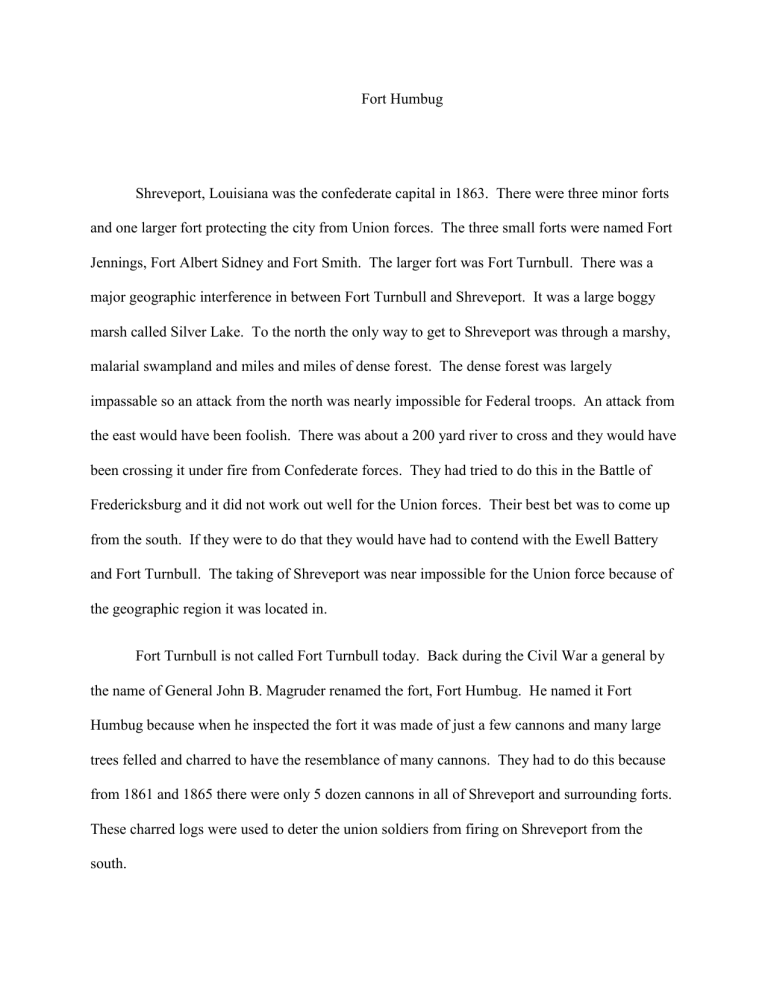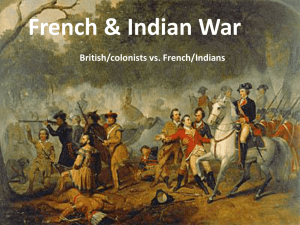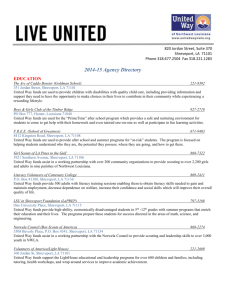Fort_humbug--byrd_cameron

Fort Humbug
Shreveport, Louisiana was the confederate capital in 1863. There were three minor forts and one larger fort protecting the city from Union forces. The three small forts were named Fort
Jennings, Fort Albert Sidney and Fort Smith. The larger fort was Fort Turnbull. There was a major geographic interference in between Fort Turnbull and Shreveport. It was a large boggy marsh called Silver Lake. To the north the only way to get to Shreveport was through a marshy, malarial swampland and miles and miles of dense forest. The dense forest was largely impassable so an attack from the north was nearly impossible for Federal troops. An attack from the east would have been foolish. There was about a 200 yard river to cross and they would have been crossing it under fire from Confederate forces. They had tried to do this in the Battle of
Fredericksburg and it did not work out well for the Union forces. Their best bet was to come up from the south. If they were to do that they would have had to contend with the Ewell Battery and Fort Turnbull. The taking of Shreveport was near impossible for the Union force because of the geographic region it was located in.
Fort Turnbull is not called Fort Turnbull today. Back during the Civil War a general by the name of General John B. Magruder renamed the fort, Fort Humbug. He named it Fort
Humbug because when he inspected the fort it was made of just a few cannons and many large trees felled and charred to have the resemblance of many cannons. They had to do this because from 1861 and 1865 there were only 5 dozen cannons in all of Shreveport and surrounding forts.
These charred logs were used to deter the union soldiers from firing on Shreveport from the south.
Shreveport was a pivotal area that the Union Army wanted during the Civil War. In 1864
Union forces under the command of Major General Nathaniel Banks decided to go on the Red
River Campaign because they needed to get Texas under Union control. It was decided that the best way to do that was to go up the Red River. Confederate General Edmund Kirby Smith with
General Richard Taylor was there to hold off the Union attack. Richard Taylor was son of former President Zachary Taylor. The Union Army took little time in taking Alexandria. At the
Battle of Mansfield Major General Banks forces were defeated. The forces would have kept on going except for two things. General Steele in Arkansas was pushed back before he even got to the Louisiana border. The other thing that deferred them from coming was that they sent scouts up to Shreveport and they came back with a report on the Fort Humbug. This had little effect though on the outcome of the war because in April General Robert E. Lee surrendered to Union forces. Confederate president Jefferson Davis was captured in Georgia trying to get to
Shreveport.
In Shreveport today there is a marker for Fort Humbug. It is a historical landmark in
North Louisiana as a tourist spot. Fort Humbug was a major factor in Shreveport being a
Confederate capital of Louisiana. The General in charge of Shreveport was General Kirby-
Smith. His ingenuity and bravery kept Shreveport from being run over by Yankee soldiers. Fort
Humbug, just a wooden fort kept Shreveport safe from Federal forces.
Sources:
Joiner, Gary D. "Civil War Trust." The Red River Campaign . Web. 03 May 2012.
<http://www.civilwar.org/battlefields/mansfield/mansfield-history-articles/redriverjoiner.html>.
"History." Caddo Parish History Site . Web. 03 May 2012.
<http://www.caddohistory.com/fort_humbug.html>.









